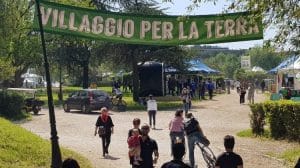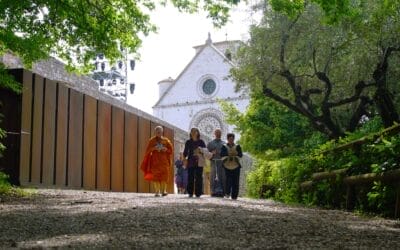The focus for discussion was safeguarding the Amazon – not only one of the richest ecosystems on the planet but also a “forest of cultures.” Look at the Amazon with the eyes of those who live there, “make yourself one ” with the indigenous peoples who inhabit it in relationships of exchange and perfect balance. While the Earth is a mother who gives life, it is humanity’s role to care for it – to protect the wealth of its creatures, while being at the same time a creature within Creation. This is the over arching vision of both the promoters and the participants of the fourth edition of the Village for the Earth, which was held in Rome promoted by the Focolare Movement together with Earth Day Italy. From April 25 to 29, they addressed the theme of safeguarding the Amazon, which has an ecosystem among the richest on the planet and at the same time contains “forest of cultures.”  From the park at Villa Borghese, the appeal was renewed for the protection of the environmental and ethnic-cultural biodiversity of the Amazon. Described as one of the Earth’s “lungs,” the Amazon has been exploited and looted for too long by multinationals and governments who see it only as a source of income. The extraction of oil, gas and precious materials, and the growing deforestation of areas destined for intensive agriculture or for the construction of dams and other infrastructure – reports Francesca Casella, Director of Survivor International Italy – is a “deliberate attack” that puts at risk the survival of the ecosystem and the tribes that inhabit it. These tribes are illegally evicted from their lands, deprived of sustenance or even exterminated. “We are hungry and thirsty for justice for all those who have died fighting for our people and for our lives,” Hamangaì, an indigenous student representative of the Patax people in the Brazilian state of Bahia, said. “We ask humanity to stop and listen to the original peoples, the bearers of thousands of years of wisdom.” This cry was answered by the hundreds of organizations, institutions and entities – civil and ecclesial – that took part in the event and agreed to work together for the protection of the Amazon, this land that constitutes an inestimable ecological heritage, but which also offers itself as a model for the coexistence of hundreds of populations with different cultures, ethnic groups and religions. It’s a model to be protected, therefore, according to the spirit indicated by the Lord to Moses in the Bible: “Take off your sandals, for the place on which you stand is holy ground” (Ex 3: 5). This was the biblical passage that Pope Francis quoted during his apostolic journey to the Amazon, in 2016, and that Cardinal Lorenzo Baldisseri, Secretary General of the Synod of Bishops, proposed once again to the participants in the Village as the model of how our we should approach encounters with the indigenous inhabitants and their land. The bishops of the world will meet in October to discuss the theme of the Amazon, searching for “New paths for the Church and for an Integral Ecology.” This is the title given to the coming Synod by the Pope. The cardinal added that the presence of the Church in the Amazon is significant, with “7 Episcopal Conferences, 106 bishops and thousands of priests and pastoral workers.” A special attention that comes from the awareness that everything is connected, as the Holy Father underlines in Laudato si ‘, where he invites everyone to an “ecological conversion”, or, in other words, to assume the interdependence of all Creation, of nature with humanity and among all peoples, and therefore to change lifestyles in order to overcome individualism and to adopt global solidarity as a criterion for action. In this sense we can look at the work of the Capuchin Friars of the Holy Land, who are present in 72 villages living alongside indigenous peoples. They are also engaged in the fight against prejudice towards the indigenous peoples. While the indigenous are seen, by some, as backward peoples, the Friars assert that there is much to be learnt from them. “We are slaves of time, while being with them you understand how sacred it is to be together, to listen to each other,” says Father Paolo Maria Braghini, a Capuchin missionary for 20 years in the Amazon. He adds, “St. Francis would be happy to live today in that part of the world.” According to Rafael Padilha, professor at the University of Vale do Itajaì, in Brazil, this Amazonian model in its biodiversity, can and must be replicated elsewhere – while adapted to individual realities. He also emphasized the importance of promoting an economy that puts the person at the centre, for example through projects like those inspired by the Economy of Communion born of the charism of the Focolare Movement. Father Laurent Mazas, Executive Director of the Cortile dei Gentili, stated that the challenge, even in the so-called developed countries .is to move from multiculturality to interculturality, “from duel to duet, respecting the treasures of each culture.” At the end of the talk, in the Magnolia Avenue of the Villa Borghese, as a testimony to the common commitment to safeguard the forest and the peoples that inhabit it, a holm oak tree was planted in some soil from the Amazon.
From the park at Villa Borghese, the appeal was renewed for the protection of the environmental and ethnic-cultural biodiversity of the Amazon. Described as one of the Earth’s “lungs,” the Amazon has been exploited and looted for too long by multinationals and governments who see it only as a source of income. The extraction of oil, gas and precious materials, and the growing deforestation of areas destined for intensive agriculture or for the construction of dams and other infrastructure – reports Francesca Casella, Director of Survivor International Italy – is a “deliberate attack” that puts at risk the survival of the ecosystem and the tribes that inhabit it. These tribes are illegally evicted from their lands, deprived of sustenance or even exterminated. “We are hungry and thirsty for justice for all those who have died fighting for our people and for our lives,” Hamangaì, an indigenous student representative of the Patax people in the Brazilian state of Bahia, said. “We ask humanity to stop and listen to the original peoples, the bearers of thousands of years of wisdom.” This cry was answered by the hundreds of organizations, institutions and entities – civil and ecclesial – that took part in the event and agreed to work together for the protection of the Amazon, this land that constitutes an inestimable ecological heritage, but which also offers itself as a model for the coexistence of hundreds of populations with different cultures, ethnic groups and religions. It’s a model to be protected, therefore, according to the spirit indicated by the Lord to Moses in the Bible: “Take off your sandals, for the place on which you stand is holy ground” (Ex 3: 5). This was the biblical passage that Pope Francis quoted during his apostolic journey to the Amazon, in 2016, and that Cardinal Lorenzo Baldisseri, Secretary General of the Synod of Bishops, proposed once again to the participants in the Village as the model of how our we should approach encounters with the indigenous inhabitants and their land. The bishops of the world will meet in October to discuss the theme of the Amazon, searching for “New paths for the Church and for an Integral Ecology.” This is the title given to the coming Synod by the Pope. The cardinal added that the presence of the Church in the Amazon is significant, with “7 Episcopal Conferences, 106 bishops and thousands of priests and pastoral workers.” A special attention that comes from the awareness that everything is connected, as the Holy Father underlines in Laudato si ‘, where he invites everyone to an “ecological conversion”, or, in other words, to assume the interdependence of all Creation, of nature with humanity and among all peoples, and therefore to change lifestyles in order to overcome individualism and to adopt global solidarity as a criterion for action. In this sense we can look at the work of the Capuchin Friars of the Holy Land, who are present in 72 villages living alongside indigenous peoples. They are also engaged in the fight against prejudice towards the indigenous peoples. While the indigenous are seen, by some, as backward peoples, the Friars assert that there is much to be learnt from them. “We are slaves of time, while being with them you understand how sacred it is to be together, to listen to each other,” says Father Paolo Maria Braghini, a Capuchin missionary for 20 years in the Amazon. He adds, “St. Francis would be happy to live today in that part of the world.” According to Rafael Padilha, professor at the University of Vale do Itajaì, in Brazil, this Amazonian model in its biodiversity, can and must be replicated elsewhere – while adapted to individual realities. He also emphasized the importance of promoting an economy that puts the person at the centre, for example through projects like those inspired by the Economy of Communion born of the charism of the Focolare Movement. Father Laurent Mazas, Executive Director of the Cortile dei Gentili, stated that the challenge, even in the so-called developed countries .is to move from multiculturality to interculturality, “from duel to duet, respecting the treasures of each culture.” At the end of the talk, in the Magnolia Avenue of the Villa Borghese, as a testimony to the common commitment to safeguard the forest and the peoples that inhabit it, a holm oak tree was planted in some soil from the Amazon.
Claudia Di Lorenzi




0 Comments